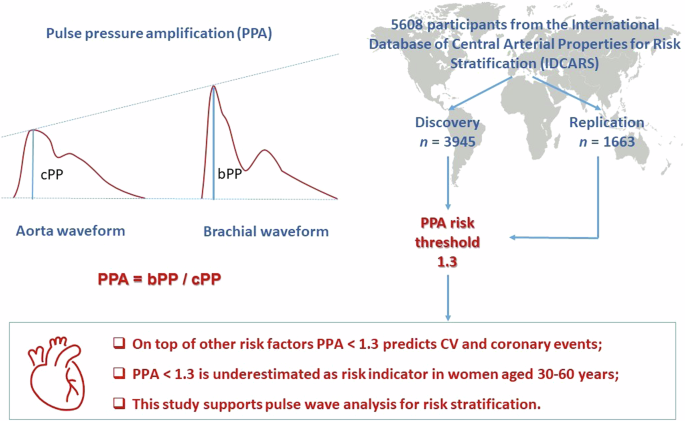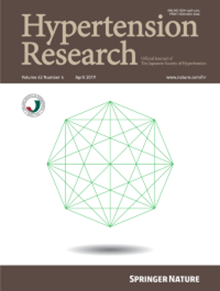以结果为导向的脉压放大阈值
IF 4.3
2区 医学
Q1 PERIPHERAL VASCULAR DISEASE
引用次数: 0
摘要
脉压放大(PPA)是指肱动脉与主动脉的脉压比值,会随着年龄和心血管风险因素的增加而降低。这项由个人参与的人群研究荟萃分析旨在确定 PPA 的结果驱动阈值。通过 SphygmoCor 软件评估了与 PPA 相关的心血管和冠心病终点的发病率和标准化多变量调整危险比 (HR),并在用于风险分层的中央动脉特性国际数据库(n = 5608)中进行了评估。模型的完善程度通过综合辨别率(IDI)和净再分类率(NRI)的提高来评估。年龄从 30 岁到 96 岁不等(中位数为 53.6 岁)。在 4.1 年的时间里(中位数),分别有 255 和 109 名参与者出现心血管或冠心病终点。在随机定义的 3945 人发现子集中,整数风险携带 PPA 临界值趋同于 1.3。对比 PPA < 1.3 与≥1.3,心血管和冠心病终点的 HR 分别为 1.54(95% 置信区间 [CI]:1.00-2.36)和 2.45(CI:1.20-5.01)。模型校准良好,结果在作为测试数据集进行分析的其余 1663 人中得到了重复,NRI 对两个终点都有显著影响。在 60 岁与≥60 岁的人群中,每个 PPA 临界值与心血管和冠心病终点相关的 HR 分别为 3.86 vs 1.19 和 6.21 vs 1.77。高风险女性(PPA 为 1.3)的比例在年轻时更高(60 岁 vs ≥60 岁:67.7% vs 61.5%;P 为 0.001)。总之,除了常见的风险因素外,肱动脉与中央动脉的PP比值达到<1.3是心血管冠状动脉并发症的先兆,也是30-60岁女性中被低估的风险因素。我们的研究支持将脉搏波分析用于风险分层。本文章由计算机程序翻译,如有差异,请以英文原文为准。


An outcome-driven threshold for pulse pressure amplification
Pulse pressure amplification (PPA) is the brachial-to-aortic pulse pressure ratio and decreases with age and cardiovascular risk factors. This individual-participant meta-analysis of population studies aimed to define an outcome-driven threshold for PPA. Incidence rates and standardized multivariable-adjusted hazard ratios (HRs) of cardiovascular and coronary endpoints associated with PPA, as assessed by the SphygmoCor software, were evaluated in the International Database of Central Arterial Properties for Risk Stratification (n = 5608). Model refinement was assessed by the integrated discrimination (IDI) and net reclassification (NRI) improvement. Age ranged from 30 to 96 years (median 53.6). Over 4.1 years (median), 255 and 109 participants experienced a cardiovascular or coronary endpoint. In a randomly defined discovery subset of 3945 individuals, the rounded risk-carrying PPA thresholds converged at 1.3. The HRs for cardiovascular and coronary endpoints contrasting PPA < 1.3 vs ≥1.3 were 1.54 (95% confidence interval [CI]: 1.00–2.36) and 2.45 (CI: 1.20–5.01), respectively. Models were well calibrated, findings were replicated in the remaining 1663 individuals analyzed as test dataset, and NRI was significant for both endpoints. The HRs associating cardiovascular and coronary endpoints per PPA threshold in individuals <60 vs ≥60 years were 3.86 vs 1.19 and 6.21 vs 1.77, respectively. The proportion of high-risk women (PPA < 1.3) was higher at younger age (<60 vs ≥60 years: 67.7% vs 61.5%; P < 0.001). In conclusion, over and beyond common risk factors, a brachial-to-central PP ratio of <1.3 is a forerunner of cardiovascular coronary complications and is an underestimated risk factor in women aged 30–60 years. Our study supports pulse wave analysis for risk stratification.
求助全文
通过发布文献求助,成功后即可免费获取论文全文。
去求助
来源期刊

Hypertension Research
医学-外周血管病
CiteScore
7.40
自引率
16.70%
发文量
249
审稿时长
3-8 weeks
期刊介绍:
Hypertension Research is the official publication of the Japanese Society of Hypertension. The journal publishes papers reporting original clinical and experimental research that contribute to the advancement of knowledge in the field of hypertension and related cardiovascular diseases. The journal publishes Review Articles, Articles, Correspondence and Comments.
 求助内容:
求助内容: 应助结果提醒方式:
应助结果提醒方式:


